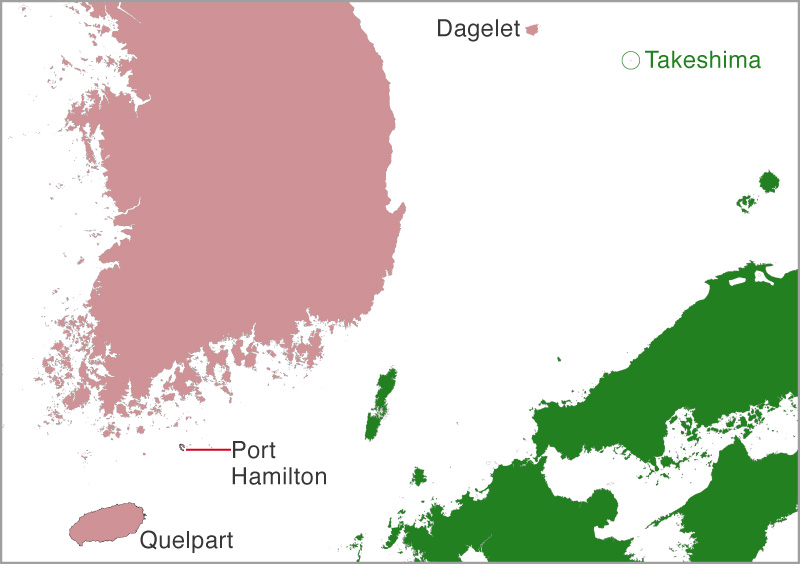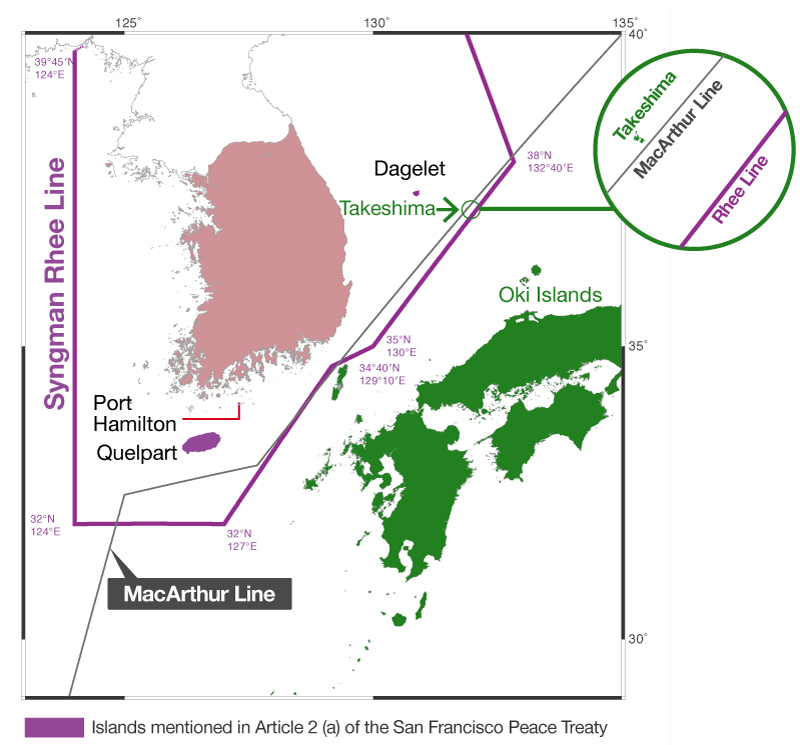Signing of the Peace Treaty
Syngman Rhee Line
September 8, 1951
Signing of the San Francisco Peace Treaty
Islands that belonged to Japan other than Honshu, Hokkaido, Kyushu, and Shikoku were determined.
San Francisco Peace Treaty
(citation)
Chapter II Territory
Article 2
(a) Japan recognizing the independence of Korea, renounces all right, title and claim to Korea, including the islands of Quelpart, Port Hamilton and Dagelet.

Developments in the ROK
January 18, 1952
The ROK President declares ‘maritime sovereignty.’
ROK President Syngman Rhee issued the declaration of ‘maritime sovereignty,’ by which the ROK unilaterally established the so-called Syngman Rhee Line in a way that would incorporate a large area on high seas, including Takeshima in this area.
Consequently, there was a rise in cases of the seizure of Japanese fishing vessels by the ROK authorities, mainly in fishing areas south of Quelpart. This was accompanied by many cases of the detention of Japanese crew members, worsening the situation.
Japan, US and other countries
Japan, the US, the UK and other countries protested against this declaration as infringing on the principle of freedom of the high seas. Japan also protested against the ROK’s territorial claims over Takeshima included in the declaration. (Japan’s protest: January 28, 1952)
US protest against the declaration of maritime sovereignty
The US expressed deep concern to the ROK, pointing out the possibility that the declaration would infringe on the rights on the high seas held by all states, and indicated that the declaration was in effect equivalent to the claim that any nation can, by declaration, convert the high seas into territorial waters.
Protest by the US
Excerpt
No. 167
American Embassy,
Pusan, February 11, 1952.
Excellency:
I have the honor to advise Your Excellency that the Government of the United States of America has taken note of the Proclamation issued by the President of the Republic of Korea on January 18, 1952 regarding Korean sovereignty over the continental shelves and certain water areas adjacent to the mainland and insular coasts of the Republic of Korea.
I am directed to inform Your Excellency that the Government of the United States of America regards with deep concern the provisions of this Proclamation. If carried into execution, this Proclamation would bring within the exclusive jurisdiction and control of the Republic of Korea wide ocean areas which have hitherto been regarded as high seas by all nations, and would in these waters and in the air spaces above supplant the free and untrammeled navigation of foreign vessels and aircraft bb such controls as the Republic of Korea, in the exercise of the sovereignty claimed, might apply. The disclaimer in Paragraph 4 does not lessen the concern of the United States Government since by the assertion of sovereignty, freedom of navigation in these areas might be claimed to be a Privilege granted b [sic] the Republic of Korea rather than a right deriving from international law.
Although the Proclamation purports to be supported by well-established international precedents, my Government is not aware of any accepted principle of international law which would qualify as a legitimate precedent for this purported extension of Korean sovereignty. In this regard, my Government wishes to call to the attention of the Republic of Korea, that, unlike the two Proclamations issued by the President of the United States of America on September 28, 1945 concerning United States policy with respect to the resources of the continental shelf and the conservation of contiguous high seas fisheries, the Korean Proclamation relates to Korean national sovereignty over the areas specified therein. The two United States Proclamations did not contemplate, nor in fact effect, any extension of the pre-existing territorial waters of the United States. On the contrary, the one has specific reference to the natural resources of the subsoil and sea bed rather than to the subsoil and sea bed so, while the other relates only to the maintenance of the productivity of the fishery resources in contiguous high seas and provides for joint action where one or more other states also have an interest in a fishery to be conserved.
With the foregoing considerations in mind, the Government of the United States of America desires to inform the Government of the Republic of Korea that it reserves all its interests and the interests of its nationals and vessels under the provisions of the Korean Proclamation in question, and under any measures designed to carry them into execution.
Accept, Excellency, the renewed assurances of my most distinguished consideration.
His Excellency
Yung-tai Pyun,
Minister of Foreign Affairs,
Republic of Korea.
MEMORANDUM
Part I: The United Government is very much interested in seeing
a just and equitable settlement of the fishing problem and the other out-
standing problems between Japan and Korea but believes that this is primarily a matter to be worked out between the two countries in the forthcoming negotiations. It is hoped that moderation on both sides and recognition of the community of interest between the two nations will lead to an equitable settlement.
Part II: The following is relevant international law and other background material.
1. The term “national sovereignty” denotes complete jurisdiction for
all purposes.
2. The term “territorial waters” is derived from the fact that the
littoral state has sovereignty over it. This distinguishes territorial
waters from the high seas over which no nation has sovereignty.
3. Despite the Republic of Korea disclaimer, the Republic of Korea
Proclamation is in effect equivalent to the claim that any nation can,
by proclamation, convert the high seas into territorial waters.
(text omitted)
February 11, 1952 (Showa 27)
[Repository] Deplomatic Archives of Ministry of Foreign Affairs ROK
| Takeshima - Top |







